With the help of painting legend Angel Giraldez, Vallejo not only changed but reinvented their venerable Game Color paint range. A more matt finish, better pigmentation, lots of new colours, but also a lot of old colours gone or changed. I’m afraid whether the new Game Color formula is really an improvement, or only catering to pro painters like Angel while neglecting the needs of us more average painters. Was the old Game Color range really so bad it needed to be redone from scratch? I answer this question and more in my review of the complete new Vallejo Game Color range.
This review is available in a video format, so I recommend watching this as there are many more examples of use to be seen here:
In October 2022, Acrylicos Vallejo relaunched their brand for the release of their new Xpress Color and Game Color ranges. They got a fancy new logo, and Angel Giraldez seems to have become Vallejo’s new brand ambassador, who also had great influence on the development of their new paint ranges, especially the new Game Color range. Vallejo and Angel completely reworked the formula, and apparently, the new Game Colors have a more matt finish, improved opacity and pigmentation, and a longer working and drying time.
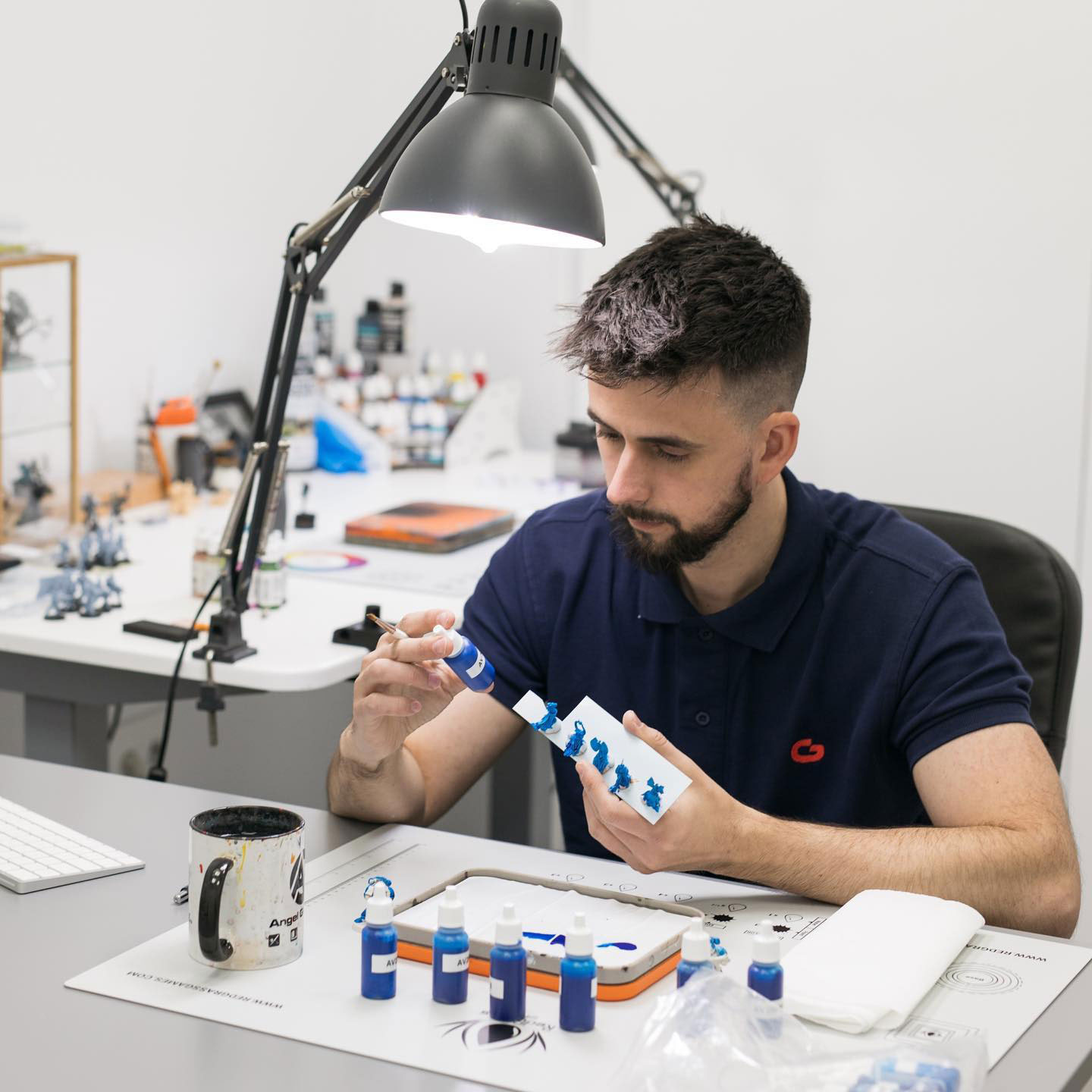

For those that don’t know, the original Game Color range was modeled after the former Citadel paint range that was discontinued in 2012. Urban legend has it that Games Workshop commissioned Vallejo to take over the production of their paint range back in the day. But when nothing came of it, Vallejo is said to have simply released the colour range on their own as Game Color. I don’t know if that’s true, but if nowadays a manufacturer were to so brazenly copy another manufacturer’s paint range colour by colour, there would probably be quite a shitstorm.
The new Vallejo Game Color range
Anyways, let’s take a look at the new range. There are 136 colours in total, which break down into 80 regular acrylics, 9 metallics, 12 inks, 8 washes, 8 fluorescent colours, 12 Special FX paints, 7 additives and varnishes, and we also have the 24 new Xpress Colors to compliment the range, bringing the number up to 160 paints. According to Vallejo’s website, the range has been designed according to a Base – Shadow – Layer system of triads, but honestly, I don’t see anything of that. Yes, some colours are arranged in triads, but some in quartets, and in between, you always find the odd colour or two. There is also no guide printed on the labels, though Vallejo’s colour chart should point you in the right direction of which colours are meant to go together. Update September 2023: Vallejo added a section with proposed triads to the Game Color pamphlet you can download from their website.
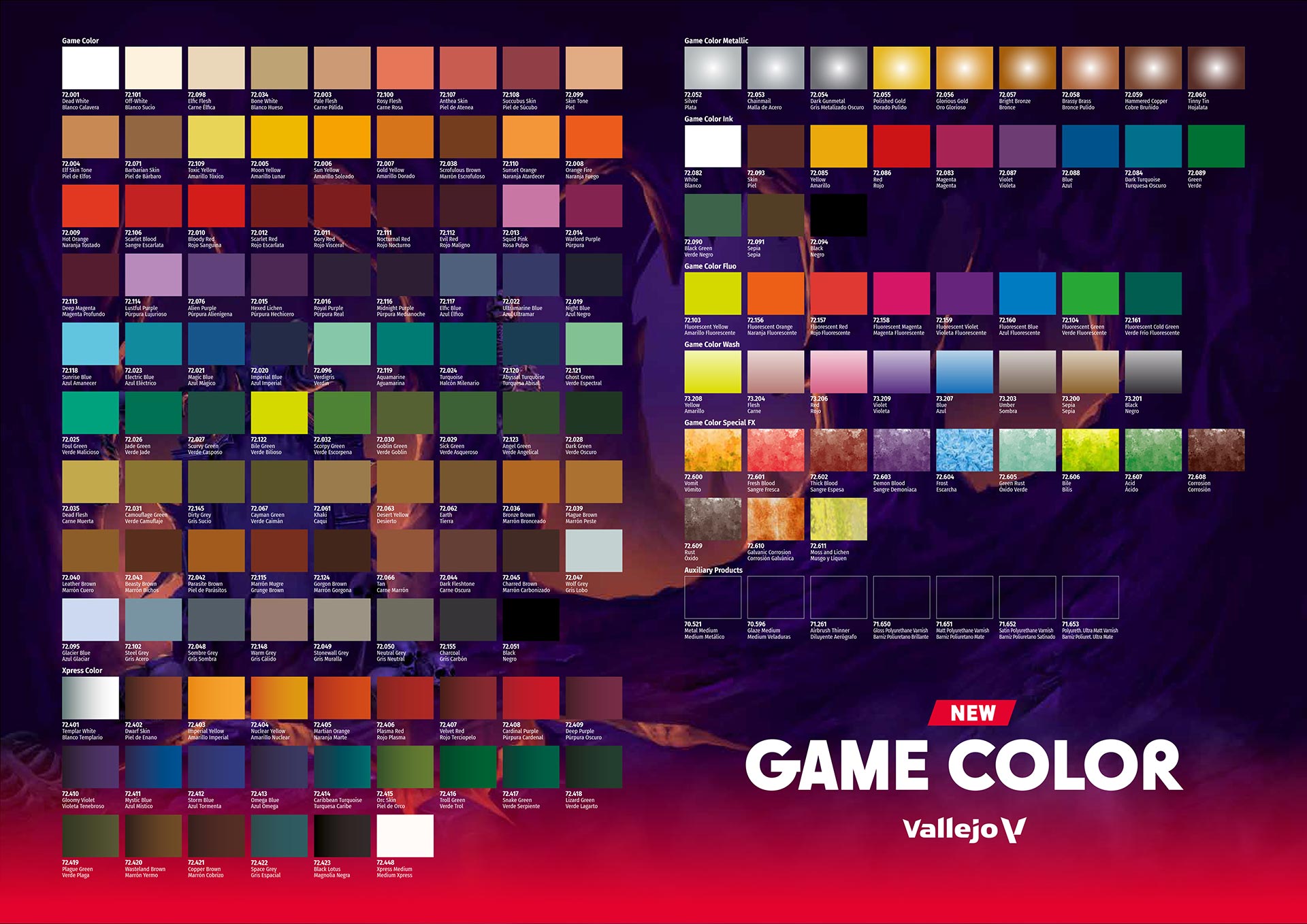

Discontinued Game Color paints
Compared to the old Game Color range, a total of 38 colours have been discontinued, namely:
- White Primer
- Pale Yellow
- Dark Blue
- Stormy Blue
- Livery Green
- Mutation Green
- Yellow Olive
- Filthy Brown
- Dwarf Skin
- Terracota
- Ghost Grey
- Heavy Skintone
- Heavy Red
- Heavy Violet
- Heavy Blue
- Heavy Bluegrey
- Heavy Grey
- Heavy Green
- Heavy Blackgreen
- Heavy Khaki
- Heavy Ochre
- Heavy Goldbrown
- Heavy Orange
- Heavy Brown
- Heavy Sienna
- Smokey Ink
- Brown Ink
- Green Wash
- Pale Grey Wash
- Rotten White
- Thick Blood
- Dry Rust
- Verdigris
- Gloss Varnish
- Satin Varnish
- Matt Varnish
- Thinner
- Crackle Medium
If you rely on any of these paints, then stock up now while the old range is still available. Some old colours have been renamed but kept their original product number, Bronze Fleshtone became Bronze Brown, Cadmium Skin became Skin Tone, Heavy Warm Grey became Warm Grey, Cold Grey became Neutral Grey, and Heavy Charcoal became just Charcoal. Also keep in mind that because of the new formula and finish, old colours that have been carried over to the new range will look slightly different, more about that later.
The new additions
There are also quite a few new colours that close some of the gaps of the old range, 44 colours in total. Nevertheless, the Game Color range is quite small compared to Citadel or Reaper, and what I’m still missing are petrol colours, more grey tones, dark skin tones, and more muted and natural light skin tones, as all of the light skin tones in the Game Color range are quite pink and peach.
For better comparison, I made a hand-painted digital colour swatch of all 136 Game Colors plus the 59 colours from the Xpress Color range. The swatch also covers the Game Air range.
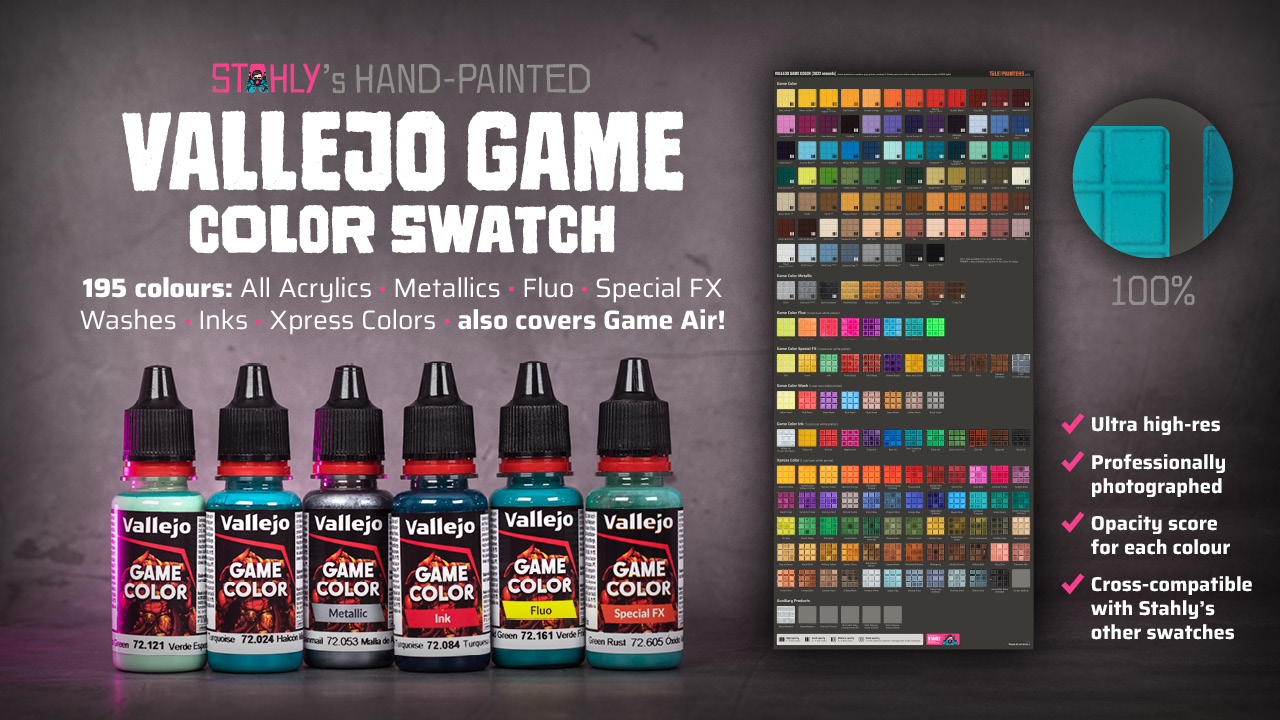

This hand-painted swatch is available in my Patreon shop for a small donation (or by becoming an Autarch tier member). I also have swatches for Citadel Colour, AK 3rd Gen, Warpaints Fanatic, and Two Thin Coats – all cross-compatible with each other so you can compare colours across different brands. Check out my shop for details.
New Game Colors’ features & properties
Well, with that out of the way, let’s delve into the paint range. The new Game Color paints come in more sustainable bottles made from recycled PET, which I really appreciate, and they also contain more paint! Old Game Color bottles had 17 ml of paint, while the new ones have 18 ml, even though the bottles look a bit smaller. The plastic used for the bottle is completely transparent so you can assess the colours better, and it also feels a bit thinner, which makes the bottles more squeezy, so watch out for accidental paint explosions. The tip has become thicker, which should make them less prone to splitting, which I welcome.
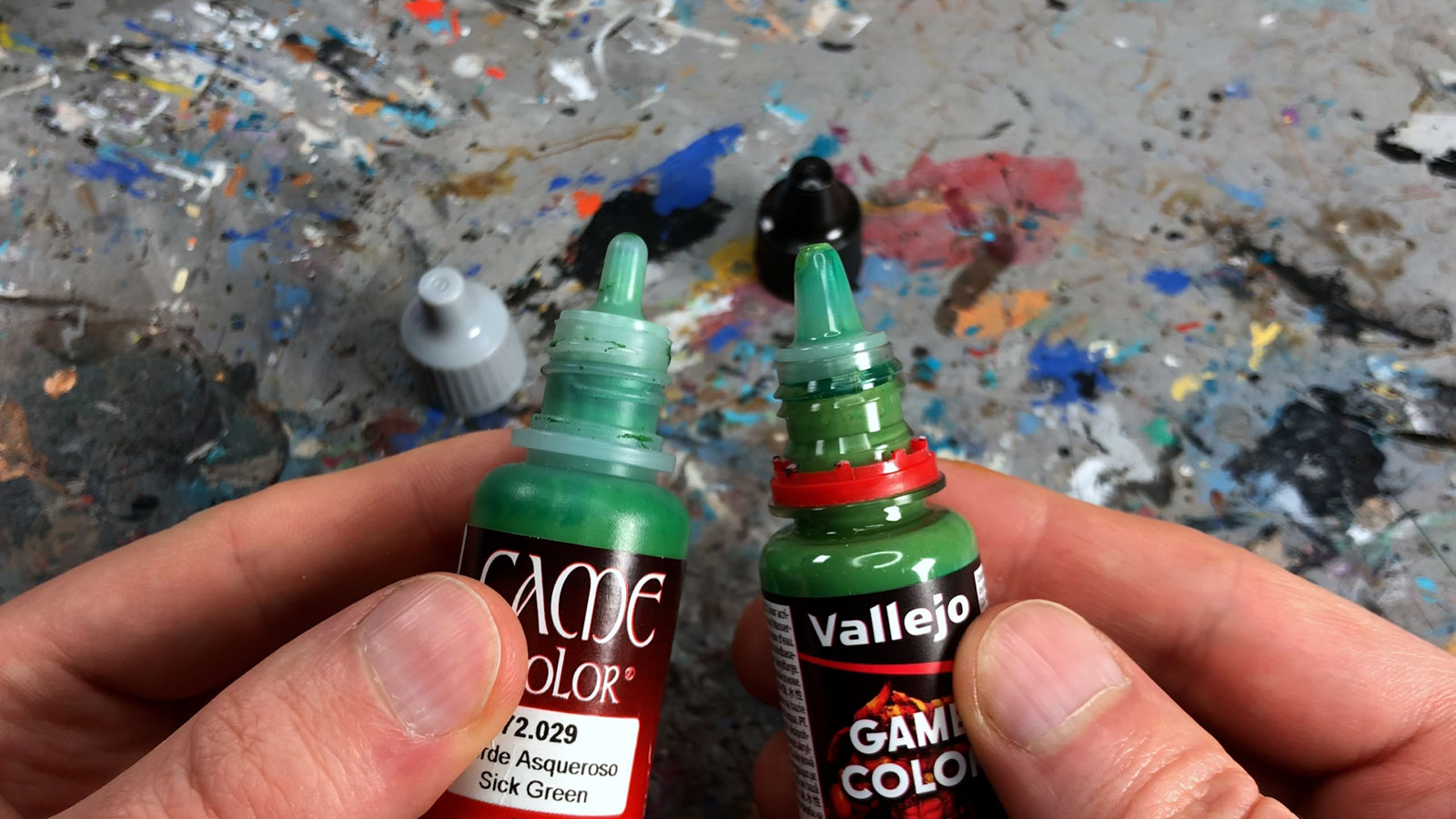

Game Color acrylics review
Let’s take a look at the 80 regular acrylic paints first. These cover most bases from all primary and secondary colours, bone, brown and skintone colours, and greyscale paints as well.
And spoiler alert: The acrylics are fantastic! Super smooth and creamy consistency, and no, they didn’t just convert them to the Model Color formula. The new Game Colors are thinner so they don’t require much if any additional dilution, but this is not at the expense of opacity as the coverage is amazing. The midtones and darker colours cover a medium grey basecoat in one to two coats, the lighter colours in two to three, and they apply so smoothly, it’s just a joy to paint with them, be it for basecoating or fine highlights.
If you’re only familiar with Citadel Colours, I would describe the new Game Colors like a freshly opened Citadel Layer paint with a little bit of water added, while retaining the opacity of a Base paint. In terms of pigmentation and creaminess, they’re definitely up there with paint ranges like AK Interactive 3rd Gen, Two Thin Coats, and ProAcryl paints. The only colours that slightly disappointed me in terms of opacity were most of the yellow and orange paints and Bile Green. Since the other colours cover so amazingly, I had hoped that Vallejo had finally cracked the code for creating yellow and orange paints that aren’t a pain in the butt, but alas… no. The Game Color yellows and oranges still require quite a lot of coats to become fully opaque. At least they are a little better than their Citadel counterparts, but don’t expect miracles.
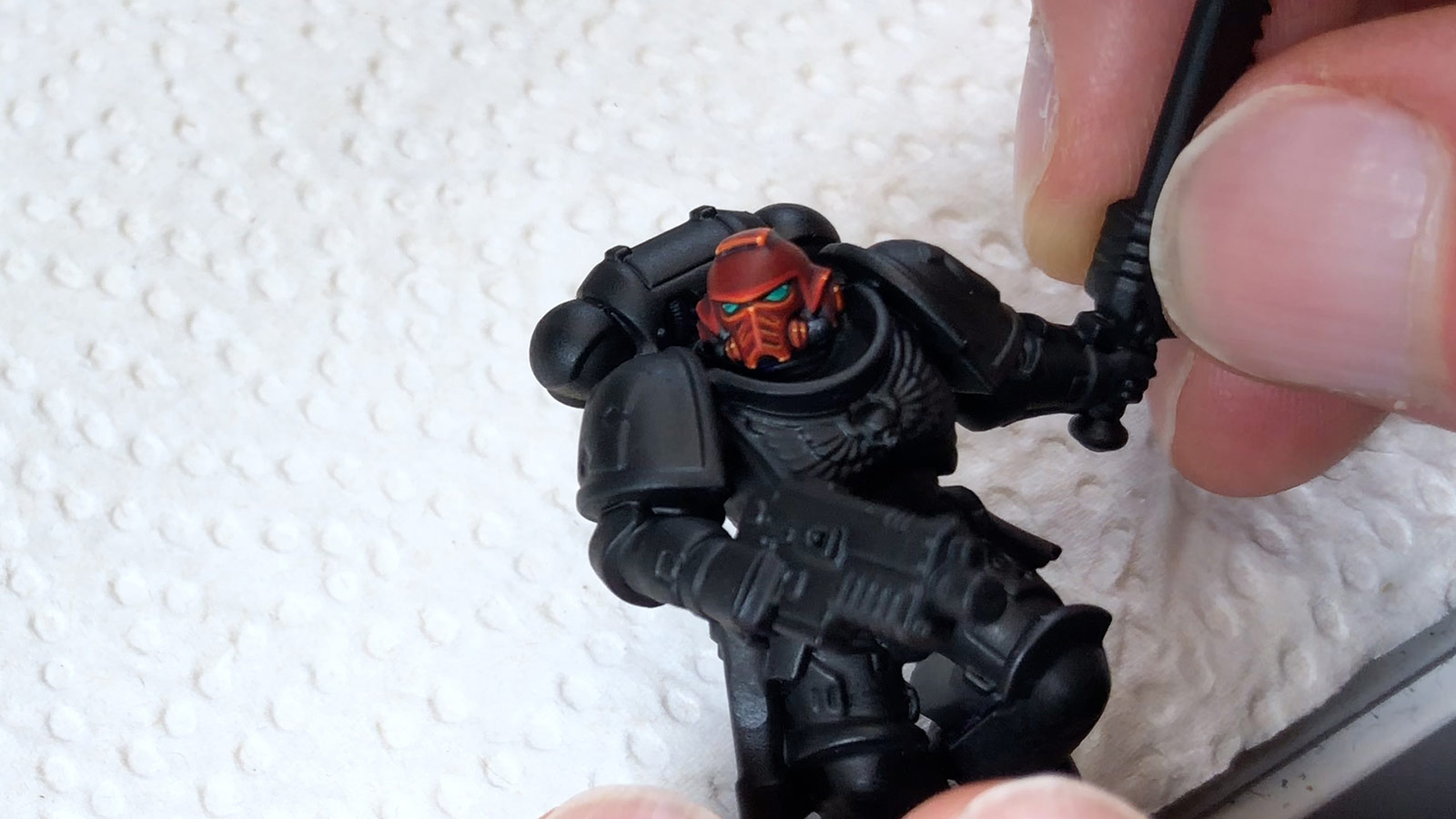

Because of their super smooth consistency, the new Game Colors also spray very well through an airbrush with a little bit of airbrush thinner, and because of the high pigmentation, they also drybrush well, though you might want to let them sit on a dry palette for a minute or two so they can thicken a little bit.
I noticed that the new formula Game Colors have a longer drying time than Citadel and The Army Painter. This is probably where Angel’s influence shows, because the longer working time makes the paints excellent for more advanced painting techniques like blending. But if you just want to paint your minis quickly, the long drying time can be a bit of a pain when applying basecoats, even when batch painting. Once dry, they are more matt than the old Game Colors, and also more matt than Citadel for sure. However, I found that the degree of mattness is not entirely consistent. Maybe it differs a bit from batch to batch, or maybe I didn’t always shake the paints long enough, but some colours are really dead flat like Vallejo Model Color or Scalecolor paints, while others are a touch more satin, but still relatively matt compared to Citadel.
Now a lot of pro painters favour matt paints, but keep in mind that matt paints are more prone to abrasion as matt resins are not as strong as more glossy ones.
Old vs. new Game Color match
But the big question remains: Are the new Game Colors compatible with the old ones? I already listed at the beginning of the video which colours have been discontinued, but what about old and new colours with the same name? Did they stay the same? Can you switch from old to new during your painting projects without any issues?
Well, first of all, the new Game Colors are more matt, which definitely changes the colour impression – matt paints look paler than glossy ones, even if they use the same pigments.
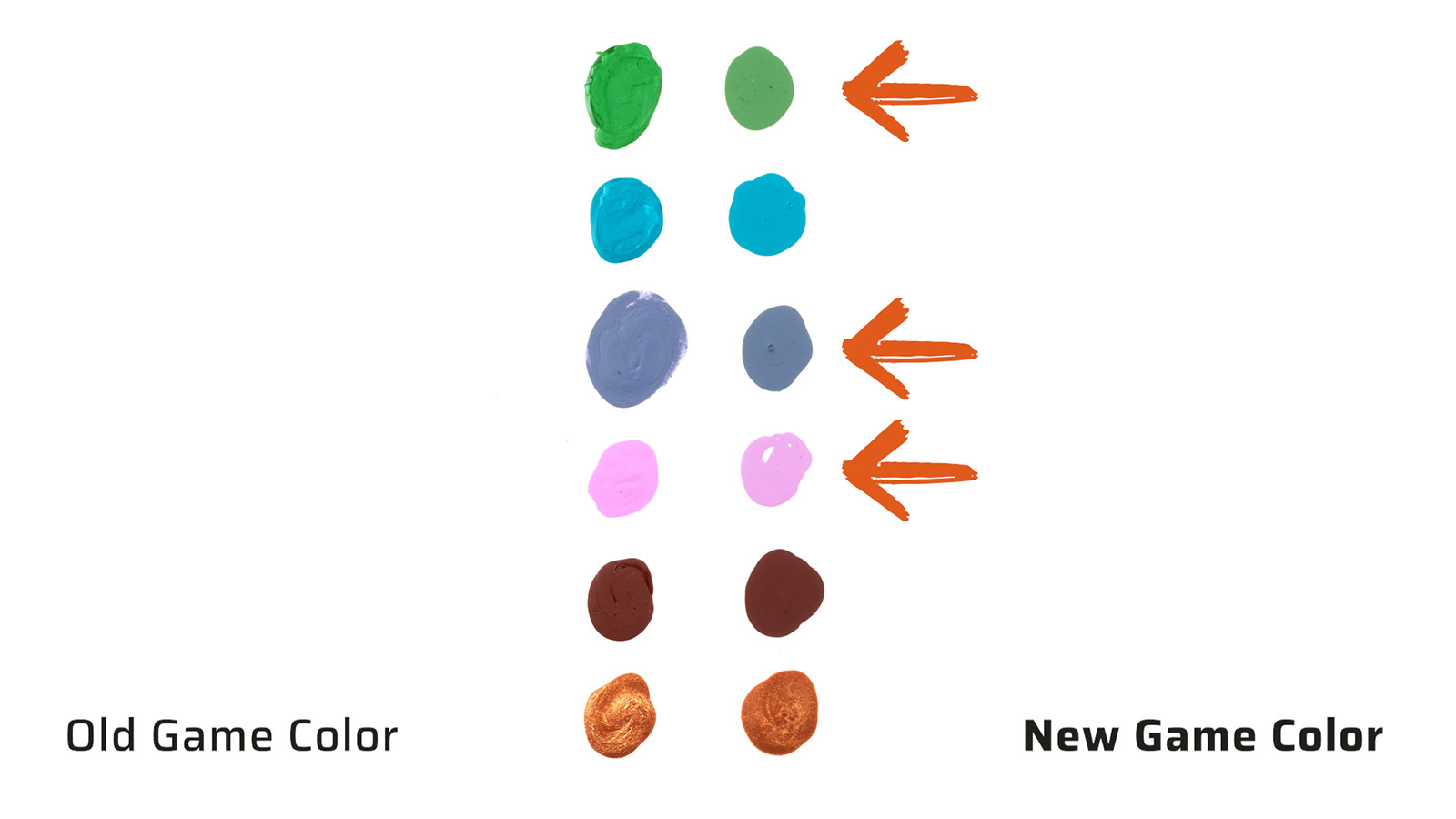

But the colours themselves have also changed slightly. As you can see here, I have randomly selected a couple old and new colours, and the difference is sometimes more, sometimes less noticeable. If you use a colour only for small details, it might not be an issue, but if, for example, you have used an old Game Color on a large area like the power armour of your Space Marines, it’s very likely that a model painted with the new Game Color will look different when standing next to a model painted with the old version. So I definitely recommend stocking up on old Game Colors you depend on as long as there are still old paints available.
But apart from these minor issues, the new Game Color acrylics are amazing, and really feel like next-gen miniature paints that are up there with more pricier paints like ProAcryl or Two Thin Coats.
Update 2024: I’ve heard from quite a few people now that they have issues with foaming and bubbling paint, mainly when applying basecoats quickly. I addressed this issue in my review of the new Model Color range, which has pretty much the same formula as the new Game Colors, click here. For this, I have to deduct a point and give the acrylics 8/10 instead of 9/10.
Game Color metallics review
Let’s move on to the metallics. And this is where it slowly starts to go downhill…
The silver paints are okay, but rather thin, their consistency is more like airbrush paint and much thinner than the old Game Color metallics. You can work with them, but they are not as good as Steel from the Vallejo Model Air series and Steel and Dark Steel from the Mecha Color series. Those are also airbrush paints, but their opacity is higher and they apply more nicely with a brush. Moreover, those three colours correspond very closely to the classic three silver paints from Games Workshop: Mithril Silver, Chainmail, and Boltgun Metal (or Stormhost Silver, Iron Hands Steel, and Leadbelcher for those that aren’t a grizzly Grey Hunter like me), whereas the new Game Color Gun Metal is significantly darker than Leadbelcher, and even darker than Iron Warriors.
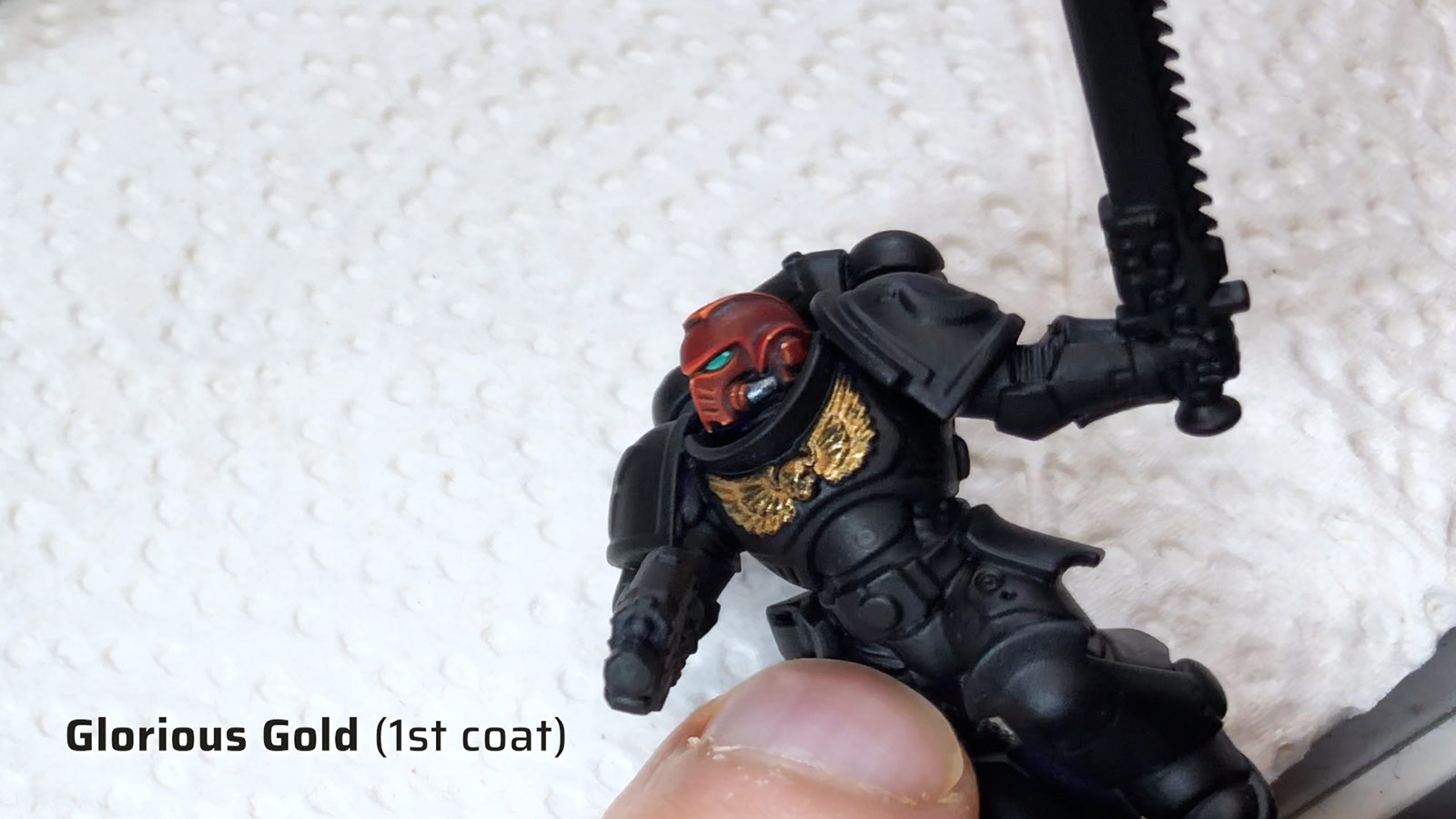

I am really disappointed with the gold colours, though. Shining Gold and Glorious Gold are not only thin but weak, and need quite a few coats to cover. By now, we have many better options for gold paints, and I recommend Retributor Armour, as well as Duncan Rhode’s Two Thin Coats and ProAcryl golds, which just cover so much better.
To a degree, the same is true for the bronze paints, which are also rather thin, here I would prefer Runelord Brass and Brass Scorpion. Hammered Copper and Tinny Tin are decent, however, and cover well.
All in all, the new Game Color Metallics are okayish except for the gold tones, but I don’t understand why Angel and Vallejo chose such a thin consistency since Vallejo already offers many pre-thinned airbrush paints with their Model Air and Game Air series. The Game Color range is a brush painting range for me, so I would have preferred a thicker consistency.
Game Color Washes review
Let’s take a look at the washes. These didn’t change very much at all and should be consistent with their old versions, but for some reason, Vallejo removed the green and grey wash, and added a yellow wash instead. While the colours themselves stayed consistent, I did notice that they flow better than the old washes, I heard they switched to a medium based on the new Xpress Color formula.
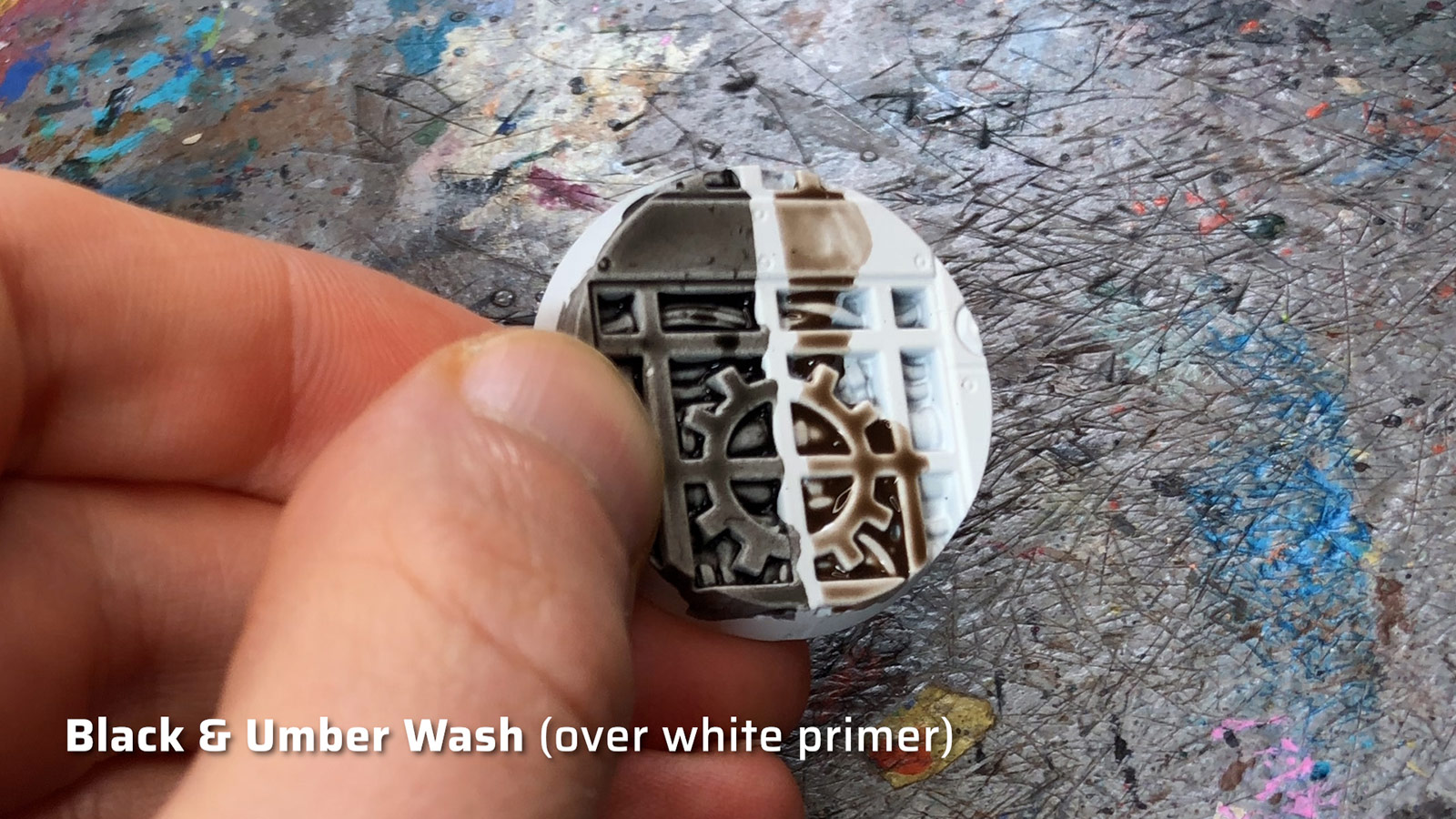

Compared to the updated Citadel Shade paints, Game Color washes are richer and have a slighter stronger tint, and they also dry more matt. Black Wash is a decent black wash, more like the old formula Nuln Oil, for those that don’t like the new formula. Umber Wash and Sepia Wash are two interesting shades of brown. I really like Umber Wash as it is a blacker brown than Agrax Earthshade. Flesh Wash is also very interesting, it’s less orange-reddish than Reikland Fleshshade, but a nuance more purple, similar in tone to Targor Rageshade but lighter. I can recommend all of these as they expand and complement the brown and flesh Shade paints from the Citadel range nicely.
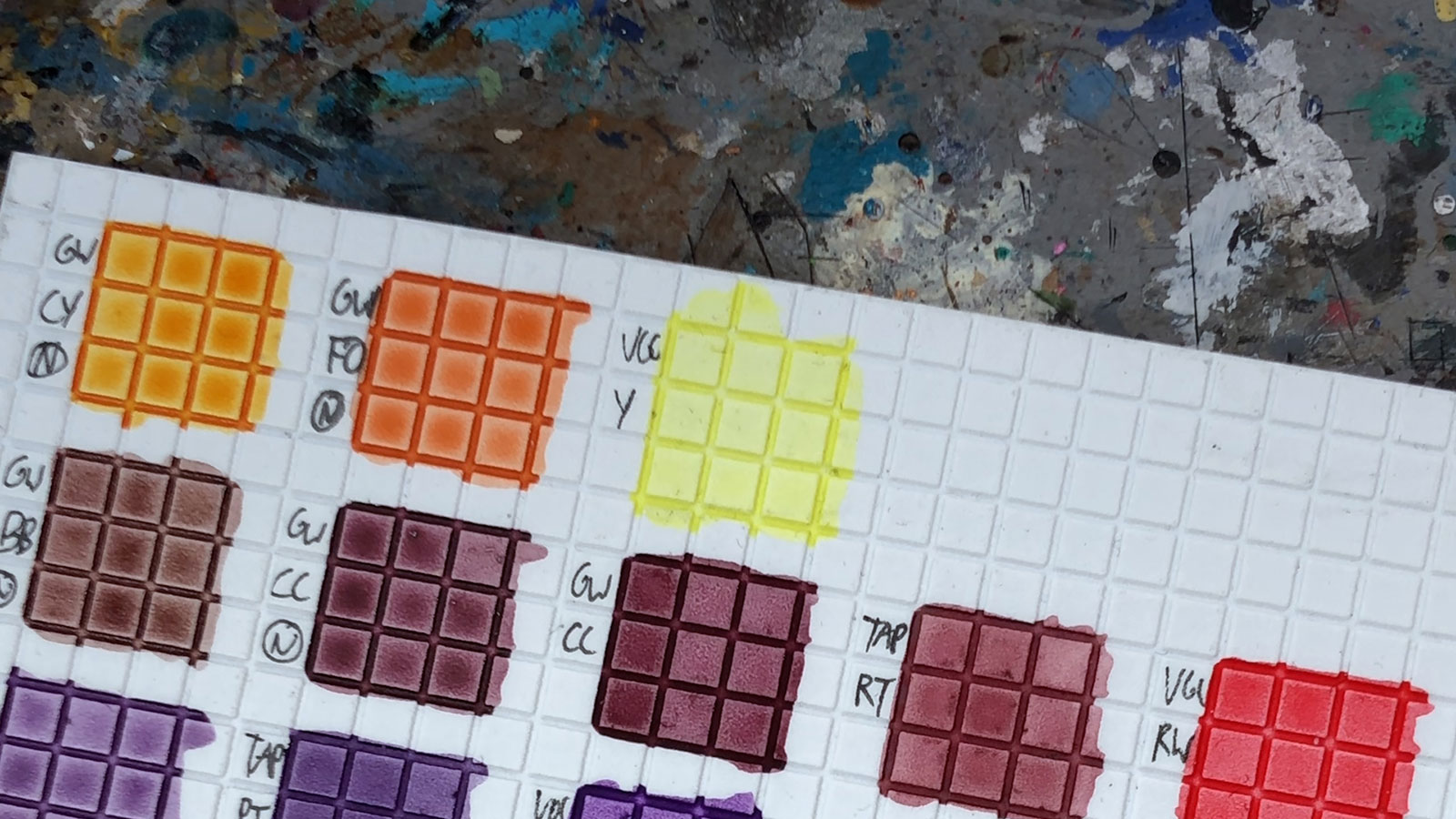

The coloured washes on the other hand are very bright compared to their counterparts from Games Workshop or The Army Painter. Especially Yellow Wash, which is almost unusable because the yellow pigment they chose is so light that you can hardly see the wash even over white primer. Red, blue and purple are ok, but the red and blue washes are also very bright, so they are only suitable for shading really light colours, which limits their usefulness.
Game Color Inks review
The Game Inks also stayed pretty much the same, which is good news for those that liked the old Game Color Inks. However, they removed Brown and Smokey Ink, which of all things were the only ones I was still using, and added a new Magenta Ink, Dark Turquoise Ink, and White Ink instead.
In general, I have moved on to Contrast-like paints. In fact, Game Color Inks and the new Xpress Colors are very similar in terms of consistency and pigmentation. The only difference is in their behaviour. As you can see, the Game Color Inks create harsher transitions as the pigments tend to collect in the recesses more, whereas Xpress Colors create a more even tint with softer transitions.
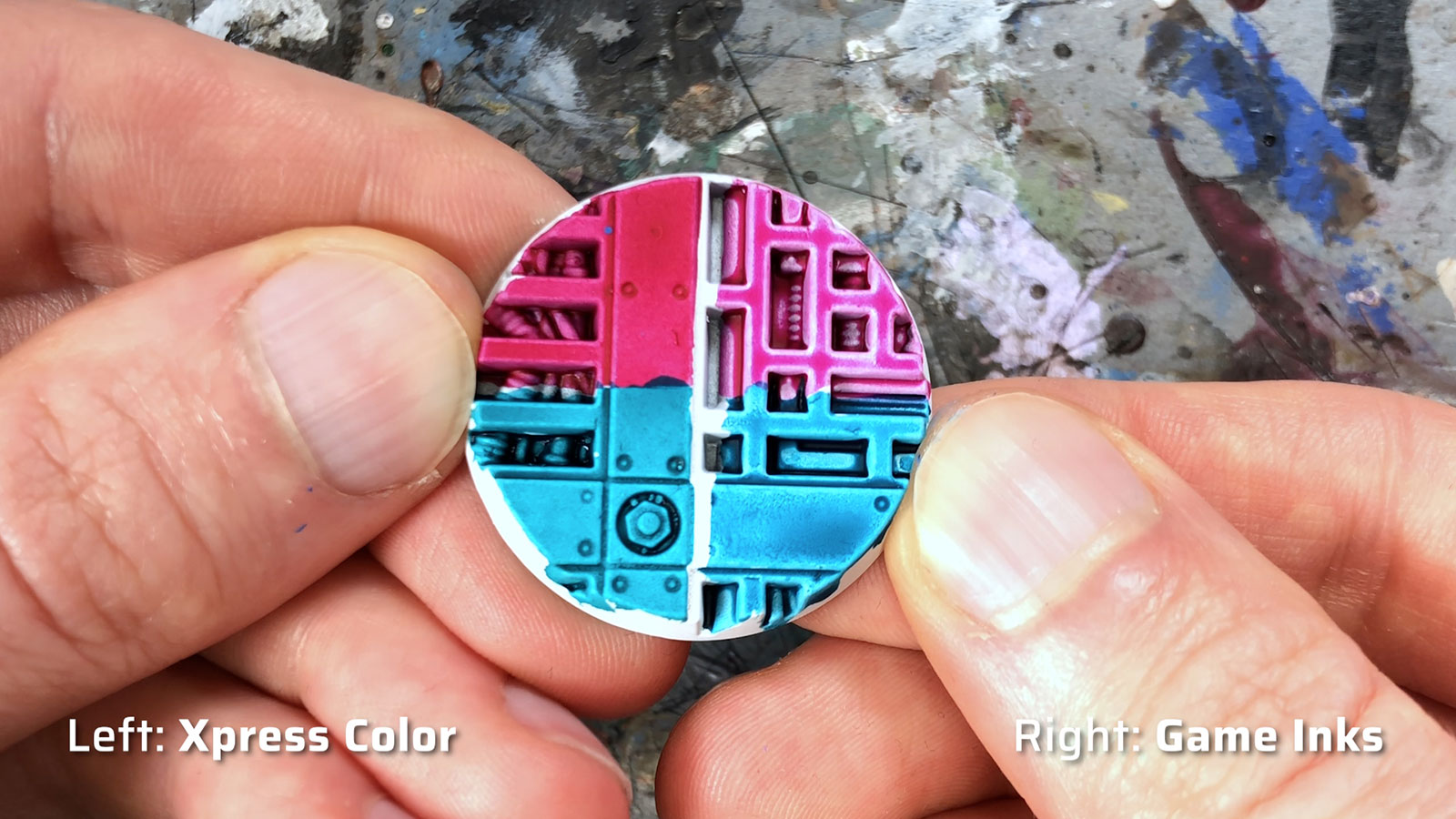

Personally, I prefer the formula of the new Xpress Colors, and I’m not sure whether having two almost identical products in a single paint range was really necessary. I would have preferred the Inks to be migrated to the Xpress Color range instead, but that’s just me. Remember, when painting miniatures it’s not always about right or wrong, but different approaches that are all equally valid. There are many roads that lead to Terra, and if you were an avid user of the old Game Color Inks then you’ll be happy they haven’t changed.
Game Color Fluorescent paints review
Now, the fluorescent paints. The selection has been greatly expanded compared to the old Game Color range, and there are some cool colours in there that you don’t see that often as fluorescent versions, for example magenta and cold green. Though I miss a typical plasma glow turquoise.
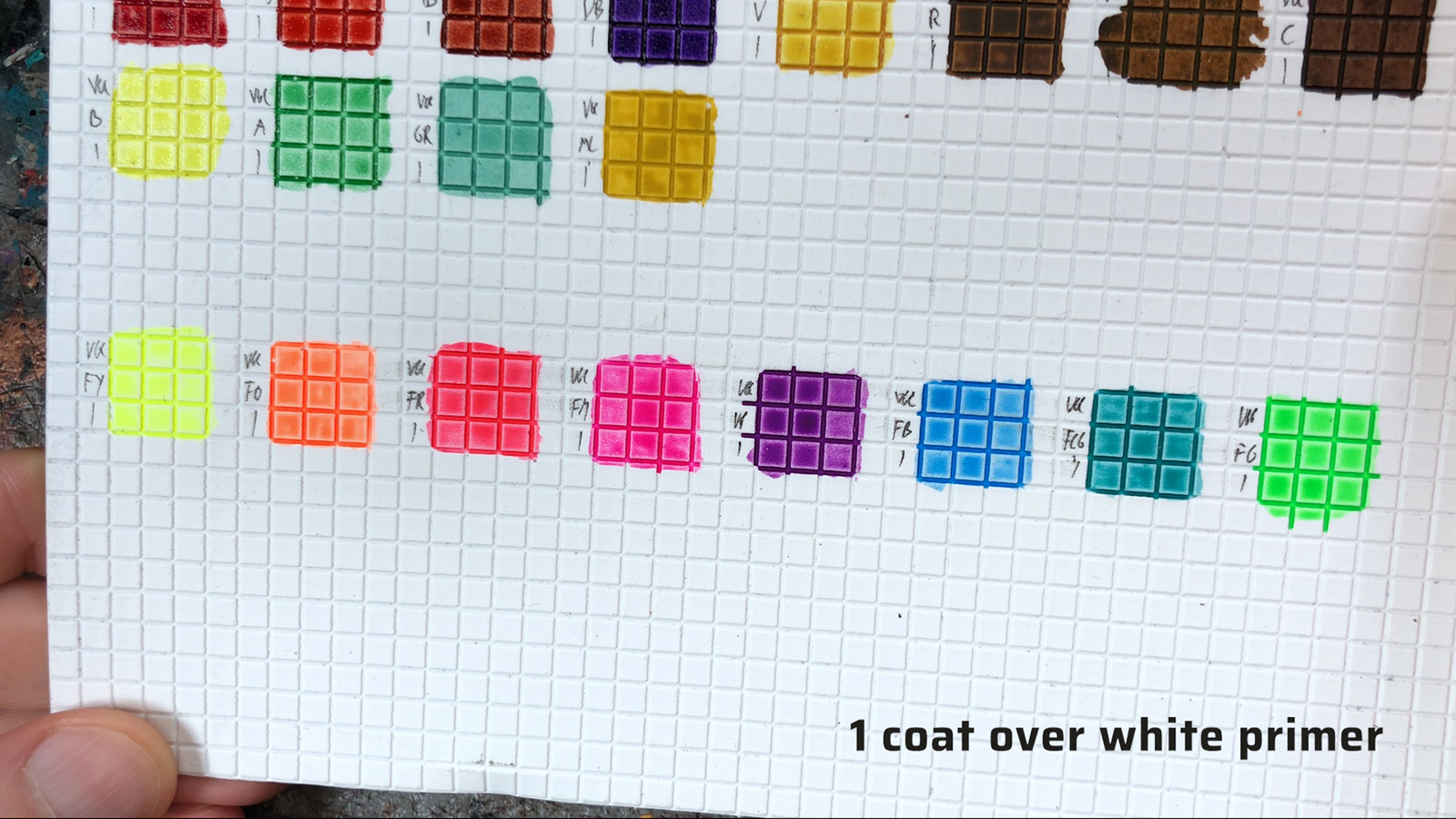

By nature, fluorescent paints tend to be rather transparent, so I recommend using the Game Color Fluo paints with an airbrush, so you can build up multiple thin layers quickly. With a brush you will need to apply lots and lots of layers for an even coverage, so if you don’t have an airbrush I recommend using them more like a glaze over a matching basecoat. It would have been great if Vallejo could have made their fluo paints more opaque, but they are on the same level as other fluorescent paints like those from the AK Interactive 3rd Gen range, so I can’t complaint too much.
Game Color Special FX paint review
The Special FX paints are Vallejo’s answer to Citadel’s Technical paints, and here I faced mixed results.
The blood colours are not bad, but in terms of consistency and behaviour, they’re practically Contrast or Xpress Colors that dry glossy. They’re lacking the gooey gel-like consistency of Blood for the Blood God I like so much. On the other hand, their red hues are a little more muted and realistic, for those who prefer that. Demon Blood is just a deep purple, and if the colour did not dry glossy, it would have been a better fit for the Xpress Color range in my opinion. Similarly, Bile, Vomit and Acid are also practically glossy Xpress Colors.
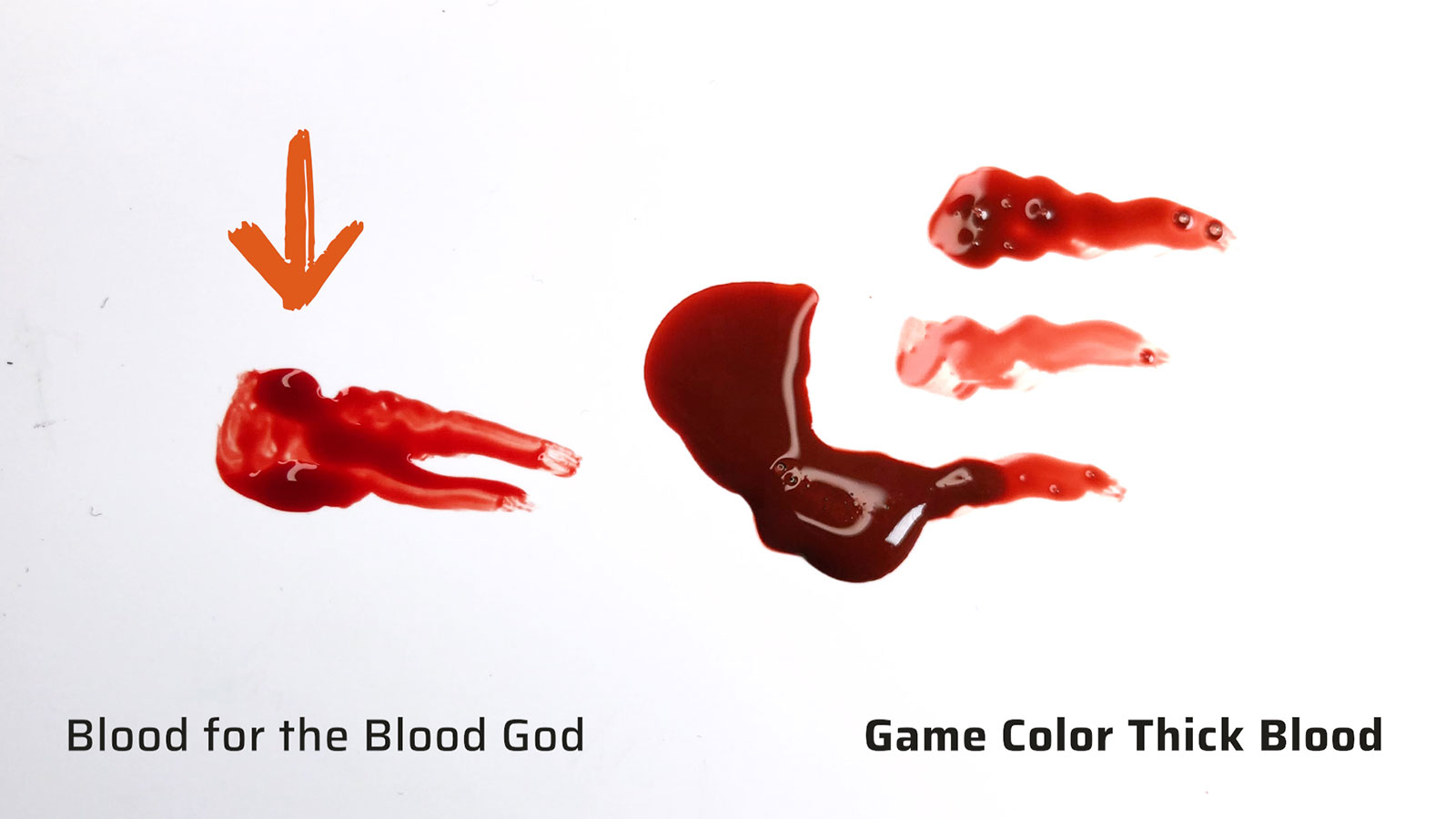

Rust, Corrosion, and Galvanic Corrosion are all very similar browns, and maybe it’s just me, but I’m really missing a more orange rust colour here. Green Rust is similar to Nihilakh Oxide, an opaque wash for creating verdigris, but in direct comparison it lacks the pigmentation of Nihilakh Oxide and is much more subtle. Moss and Lichen is a weird yellow ochre colour, no idea of how to use it for moss, I’m afraid. The most interesting FX paint is probably Frost, which is a very thin white wash. When it dries, it creates a subtle blooming effect.
All in all, with a few exceptions the Special FX colours are not bad, and better than The Army Painters’ Effect paints in my opinion. Though if in doubt, I would always go for the Technical Paints from Games Workshop. I feel these are more straight-forward to use, and do what they say on the tin better. But for those who want to create more subtle effects and like to experiment, the Game Color Special FX paints might be worth a look.
Game Color Additives & varnishes review
Last but not least, we have a few additives, like a metallic medium which is basically white metallic particles you can mix into other paints to give them a metallic sheen. There is also an airbrush thinner and glaze medium, as well as four varnishes from glossy to ultra matt.
You have to be careful with the new Game Color varnishes, because they are not water-based, unlike the old ones, but polyurethane-based. Polyurethane varnishes are more durable, but more aggressive and can reactivate Inks, Contrast and Xpress Colors as well as washes and Shade paints and also damage decals. Polyurethane varnishes are useful for preparing models for oil paints and enamel washes, but what’s the reason to put them into an acrylic paint range I don’t know. I don’t think polyurethane varnishes are suitable for the average painter, so maybe that’s a question for Angel.
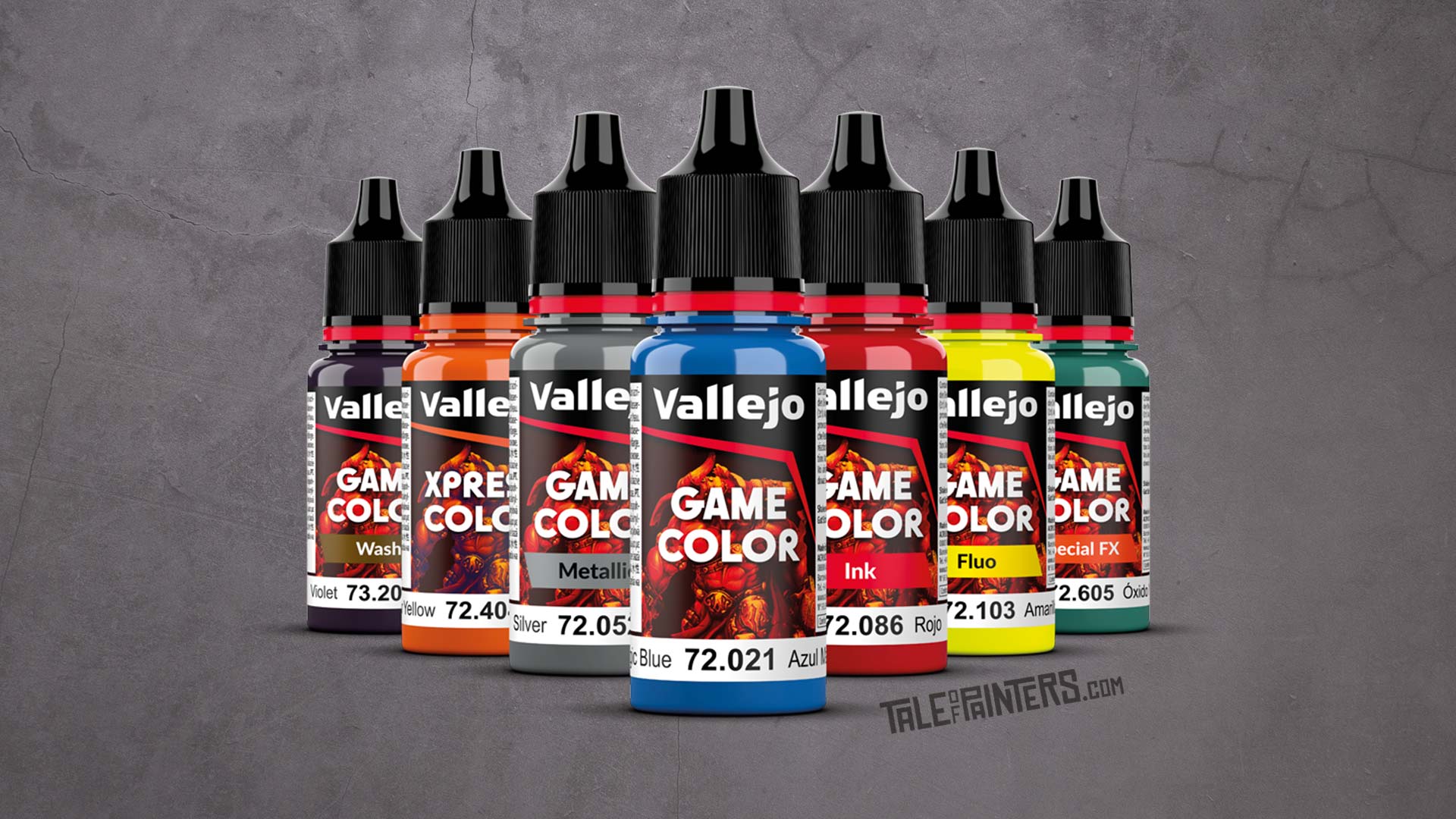

Value & verdict
And that was the complete new Game Color range in fast forward, except for the 24 Xpress Colors, which I have reviewed in a separate review.
Price-wise, the new Vallejo Game Colors are around £2.75 / 3 Euro per paint, which is a more than competitive price for 18 ml of miniature paint. Especially considering the quality of the regular acrylics.
However, Vallejo is currently having problems supplying dealers with sufficient quantities. This should hopefully change in early 2023, and then the paints should be more readily available, especially outside Europe. Check here if the paints are currently available:
You can find the latest hobby products at our 🇬🇧/🇪🇺 partner stores Wayland Games, Element Games, and Firestorm Games, at 🇩🇪 Taschengelddieb and PK-Pro, and at 🇺🇸 Noble Knight Games with a welcome discount of up to 10–15% over RRP. Using our links helps to support Tale of Painters at no additional cost to you, so thank you very much for using them!
Stahly’s paint top list
Not sure which paint range is right for you? Here are my current recommendations:
7.0Score
Pros
- Great acrylics with smooth consistency, amazing opacity and matt finish
- Black and brown washes are decent
- Inks haven’t changed much
- 44 new colours
- 18ml dropper bottles for a competitive price
Cons
- 38 colours have been discontinued
- Coloured washes are too bright
- Special FX and fluo paints are solid, but don't knock my socks off
- Metallics are rather thin and weak
- Paint can foam and leave bubble marks
Final Verdict
So now I have to give my verdict, and I have to say, I am conflicted. If I were to rate only the regular Game Color acrylics, I would have to give them a 9 or 9.5 because of their high quality, smooth consistency, and amazing opacity, and all that for a more than competitive price. To answer the question from the beginning: No, the new Game Colors aren’t just for pro painters, I think they are a significant improvement for painters of any skill level, so good job Angel and Vallejo! But apart from the acrylics, the range is quite average, which is why I had to lower my rating. If all paints would have been as spectacular as the regular acrylics, the range could have become one of (if not) the best miniature paint range out there, so kind of a missed opportunity. This might sound a bit harsh, but don’t get me wrong, the new Vallejo Game Color range is still a solid paint range.
Stahly
Related posts
21 Comments
Comments are closed.








Hey, danke für den Review. Toll, das Sie genau die eine Ink ausgenommen haben, die ich regelmäßig genutzt habe – Smokey Ink. Hast du eine gute Alternative gefunden?
Typhus Corrosion ist ähnlich, in dem Sinne das es auch Partikel enthält, farblich aber etwas anders. Ansonsten leider noch nicht 🙁
How would you compare the new game air vs new game color? I do have an airbrush but worried that if I get the air version of a colour and I need to use a brush for some highlights it might be too thin.
Perfect colour match to the GC version, they spray on nicely, but they are indeed pre-thinned you might want to grab the GC version, too. You can definitely apply them with a brush, but they are a thin.
Do the new paints still separate easily? How easy are they to shake remix any separation? I left the previous vallejo because I hated the amount of separation that happened in the bottle.
It’s not too bad, definitely better than some of the other Game Colors. Though if you leave them for a while on a wet palette, they’ll separate after a while and need to be blended again.
Thank you for the reply! I’m mostly just worried about paint separating in the bottle, as that requires a lot of shaking. Do you have any experience with p3, reaper, or ak 3rd gen? If yes, how do you feel the new vallejo game color regarding how well the paints resist separating in the bottle?
Hey thanks for the review. I can’t find any info regarding the BSL (base,shadow, light) system for this new range. i contacted vallejo but no luck.
Me neither. I think it’s just a fancy marketing term.
Just to update they released a new pdf for the new game color range that includes bsl combinations.
Do you happen to know when the full set will become available? I don’t really fancy buying them one by one with the risk of some being out of stock, but all of the shops mentioned only have singles, if any. The official european vallejo store has the “all in” set listed as unavailable currently.
No, I’m sorry. Try to contact Vallejo directly 🙂
Would you be able to post a photo of your test squares? I’d love to see a live version of each colour in the range.
Are the new game color varnishes replacing the model color ones? I exclusively use the matt one because I haven’t found a competitor that really matches the finish. I’d hate to have to go on a spending spree just to stock up like I had to with citadel when they changed the formulation of the washes.
I think Model Color will stay the same for now 🙂
Great review. About the varnishes, you can use then with water. Yes, they are polyurethane but I dont know why they can be used with water. Maybe it is an “acrylic polyurethane”? It sounds contradictory for me, but the fact is that they are water-based varnishes.
Great review. I second the other comment about polyurethane varnishes, I have been using Vallejo PU varnishes for quite some time (as they are Vallejo standard varnishes) over anything from VGA, VGC, VMC/A, citadel and army Painter and never had any reactivation, decal issues or anything.
Lucky you! I burned my fingers once when I was not aware of the difference. By interest, do you brush varnish or use and airbrush?
I am having a reactivation issue with the Xpress paints when using Vallejo PU varnish and acrylic varnish. I brush on the varnish and I find the abrasion will smear the Xpress paint. I don’t want to buy an airbrush, but I haven’t found another solution to this other than applying a very thin layer of varnish very quickly and then immediately using a hair dryer. Has anyone else figured out a way around this?
Im searching the Colour 72.141 “Heavy Red” because the heavy Colours have more Pigments. Do anyone know the new name, or which of the new Reds is good for Basecoat?
Apparently, from Vallejo’s own equivalencies chart, it’s the same colour as Vallejo Model Color 70926 Red Leather. Source: https://fantasy-in.de/media/pdf/b3/4a/b7/vallejo-game-color-CC072_Rev17.pdf
Haven’t tried it myself though, and it will likely look a bit different as Model Color is more matt than Game Color, but might be worth a try.